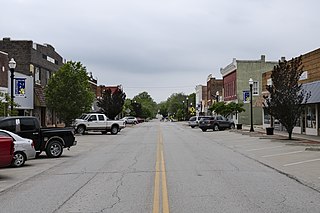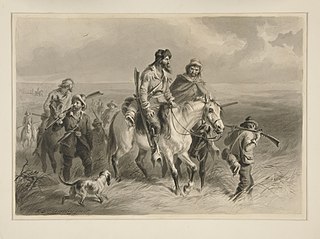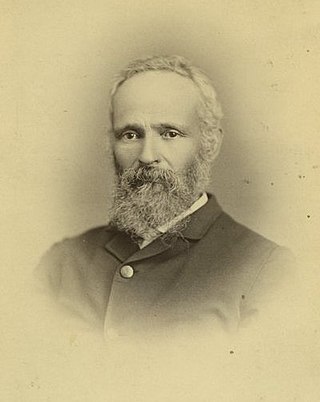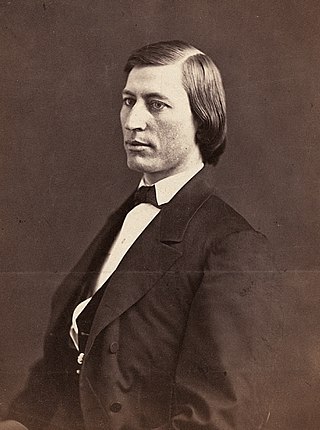
John Brown was an American abolitionist leader. First reaching national prominence for his radical abolitionism and fighting in Bleeding Kansas, he was eventually captured and executed for a failed incitement of a slave rebellion at Harpers Ferry preceding the American Civil War.

Osawatomie is a city in Miami County, Kansas, United States, 61 miles (98 km) southwest of Kansas City. As of the 2020 census, the population of the city was 4,255. It derives its name as a portmanteau of two nearby streams, the Marais des Cygnes River and Pottawatomie Creek.
The U.S. state of Kansas, located on the eastern edge of the Great Plains, was the home of nomadic Native American tribes who hunted the vast herds of bison. In around 1450 AD, the Wichita People founded the great city of Etzanoa. The city of Etzanoa was abandoned in around 1700 AD. The region was explored by Spanish conquistadores in the 16th century. It was later explored by French fur trappers who traded with the Native Americans. Most of Kansas became permanently part of the United States in the Louisiana Purchase of 1803. When the area was opened to settlement by the Kansas–Nebraska Act of 1854 it became a battlefield that helped cause the American Civil War. Settlers from North and South came in order to vote slavery down or up. The free state element prevailed.

Bleeding Kansas, Bloody Kansas, or the Border War was a series of violent civil confrontations in Kansas Territory, and to a lesser extent in western Missouri, between 1854 and 1859. It emerged from a political and ideological debate over the legality of slavery in the proposed state of Kansas.

Silas Stillman Soule was an American abolitionist, military officer and 'conductor' on the Underground Railroad. As a Kansas Jayhawker, he supported and was a proponent of John Brown's movement in the time of strife leading up to the American Civil War.

Border ruffians was a term used to refer to proslavery raiders who crossed into the Kansas Territory from Missouri during the mid-19th century to help ensure the territory entered the United States as a slave state. Their activities formed a major part of a series of violent civil confrontations known as "Bleeding Kansas", which peaked from 1854 to 1858. Crimes committed by border ruffians included electoral fraud, intimidation, assault, property damage and murder; many border ruffians took pride in their reputation as criminals. After the outbreak of the American Civil War in 1861, many border ruffians fought on the side of the Confederate States of America as irregular bushwhackers.

The sacking of Lawrence occurred on May 21, 1856, when pro-slavery settlers, led by Douglas County Sheriff Samuel J. Jones, attacked and ransacked Lawrence, Kansas, a town which had been founded by anti-slavery settlers from Massachusetts who were hoping to make Kansas a free state. The incident fueled the irregular conflict in Kansas Territory that later became known as Bleeding Kansas.
The Pottawatomie massacre occurred on the night of May 24–25, 1856, in the Kansas Territory. In reaction to the sacking of Lawrence by pro-slavery forces on May 21, and the telegraphed news of the severe attack on May 22 on Massachusetts Senator Charles Sumner, for speaking out against slavery in Kansas, John Brown and a band of abolitionist settlers—some of them members of the Pottawatomie Rifles—responded violently. Just north of Pottawatomie Creek, in Franklin County, they killed five pro-slavery settlers in front of their families. This soon became the most famous of the many violent episodes of the "Bleeding Kansas" period, during which a state-level civil war in the Kansas Territory was described as a "tragic prelude" to the American Civil War which soon followed. "Bleeding Kansas" involved conflicts between pro- and anti-slavery settlers over whether the Kansas Territory would enter the Union as a slave state or a free state. It is also John Brown's most questionable act, both to his friends and his enemies. In the words of abolitionist Frederick Douglass, it was "a terrible remedy for a terrible malady."
The Wakarusa War was an armed standoff that took place in the Kansas Territory during November and December 1855. It is often cited by historians as the first instance of violence during the "Bleeding Kansas" conflict between anti-slavery and pro-slavery factions in the region.

The Battle of Black Jack took place on June 2, 1856, when antislavery forces, led by the noted abolitionist John Brown, attacked the encampment of Henry C. Pate near Baldwin City, Kansas. The battle is cited as one incident of "Bleeding Kansas" and a contributing factor leading up to the American Civil War of 1861 to 1865.
The Battle of Osawatomie was an armed engagement that occurred on August 30, 1856, when 250–400 pro-slavery Border ruffians, led by John W. Reid, attacked the town of Osawatomie, Kansas, which had been settled largely by anti-slavery Free-Staters. Reid was intent on destroying the Free-State settlement and then moving on to Topeka and Lawrence to do more of the same. Abolitionist John Brown first learned of the raiders when they shot his son Frederick. With just 40 or so men, Brown tried to defend the town against the pro-slavery partisans, but ultimately was forced to withdraw; five Free-Staters were killed in the battle, and the town of Osawatomie was subsequently looted and burned by Reid's men. The battle was one of a series of violent clashes between abolitionists and pro-slavery partisans in Kansas and Missouri during the Bleeding Kansas era.
The timeline of Kansas details past events that happened in what is present day Kansas. Located on the eastern edge of the Great Plains, the U.S. state of Kansas was the home of sedentary agrarian and hunter-gatherer Native American societies, many of whom hunted American bison. The region first appears in western history in the 16th century at the time of the Spanish conquest of the Aztec Empire, when Spanish conquistadors explored the unknown land now known as Kansas. It was later explored by French fur trappers who traded with the Native Americans. It became part of the United States in the Louisiana Purchase of 1803. In the 19th century, the first American explorers designated the area as the "Great American Desert."

Pottawatomie Township is a township in Franklin County, Kansas, USA. As of the 2000 census, its population was 669.

John Brown Jr. was the eldest son of the abolitionist John Brown. His mother was Brown's first wife, Dianthe Lusk Brown, who died when John Jr. was 11. He was born in Hudson, Ohio. In 1841 he tried teaching in a country school, but left it after one year, finding it frustrating and the children "snotty". In spring 1842 he enrolled at the Grand River Institute in Austinburg, Ohio. In July 1847 he married Wealthy Hotchkiss (1829–1911). The couple settled in Springfield, Massachusetts and had two children.

The Marais des Cygnes Massacre Site, also known as Marais des Cygnes Massacre Memorial Park, is a state historic site near Trading Post, Kansas that commemorates the 1858 massacre of the same name. On May 19, 1858, during a period of political instability and sporadic violence known as Bleeding Kansas, a group of pro-slavery border ruffians captured 11 abolitionist free-staters. The prisoners were forced to a nearby ravine, where 10 of them were shot, resulting in five fatalities. The abolitionist John Brown later built a fort near the site. The first commemoration at the site was two stone markers erected by men of the 3rd Iowa Cavalry Regiment in 1864, although these monuments had been destroyed by souvenir hunters by 1895. In 1941, the land where the massacre occurred, as well as an 1870s-era house constructed by a friend of Brown, were transferred to the state of Kansas. The site was listed on the National Register of Historic Places in 1971 and designated a National Historic Landmark in 1974. The Kansas Historical Society administers the site, which is interpreted by signage and a hand-cranked audio recording.

August Bondi was an Austrian-American Jew involved in the Border War and later the American Civil War. In Kansas, he was a part of the Pottawatomie Rifles and fought alongside abolitionists John Brown and James Lane.

Thaddeus Hyatt was an American abolitionist and inventor. In his opposition to slavery, Hyatt organized the efforts of abolitionists in Kansas to have the territory admitted to the Union as a free-state and campaigned for the federal government to aid Kansans afflicted by drought. Hyatt befriended John Brown and provided Brown with financial support; following the raid on Harpers Ferry, Hyatt was investigated by a committee of the United States Senate. When Hyatt refused to comply with a Congressional subpoena and cooperate with the Senate investigation, the Senate voted to jail the recalcitrant abolitionist. As an inventor, Hyatt was a wealthy man, profiting from his invention of iron-and-glass vault covers for admitting sunlight to spaces below sidewalks and pavements. Hyatt also innovated and patented several designs for reinforced concrete floors.

Henry Clay Pate was an American writer, newspaper publisher and soldier. A strong advocate of slavery, he was a border ruffian in the "Bleeding Kansas" unrest. He is best known for his conflict with, and capture by, the abolitionist John Brown.
The Stubbs were a Free-Stater militia group active in Kansas, United States during the Bleeding Kansas era. They fought in the Battle of Franklin and the capture of Fort Saunders. Along with their duties as a military defense force, the Stubbs also operated as a policing force, arresting criminals. The Stubbs had a membership of 60 on their absorption into the Union Army.












